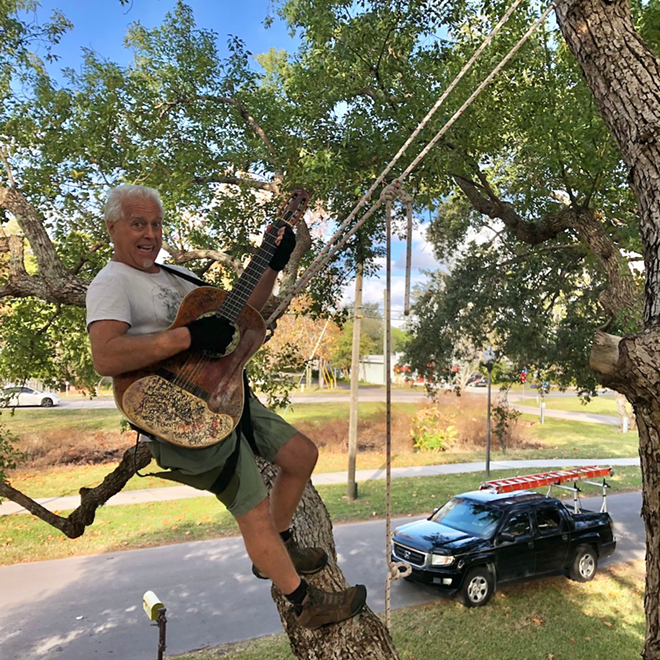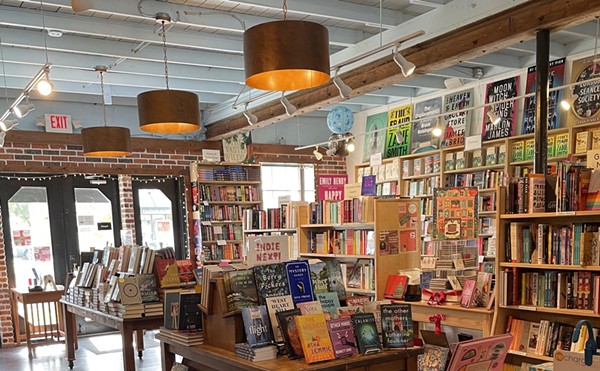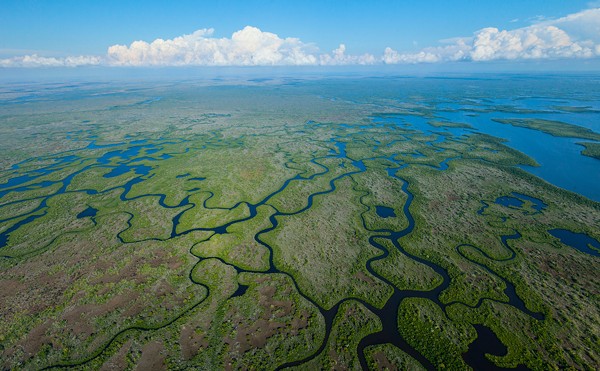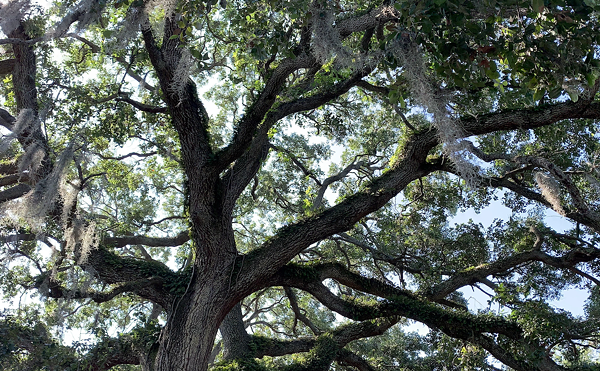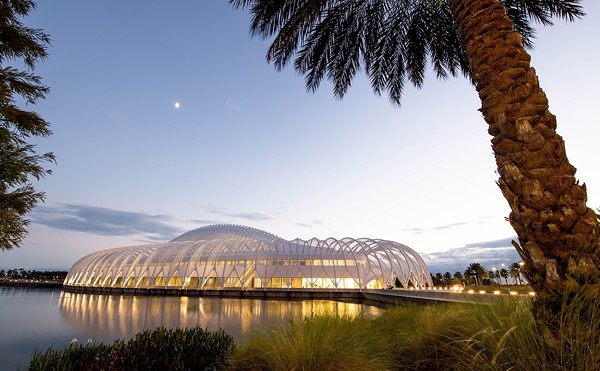“Life begins at the end of your comfort zone,” says Capt. Barney Waterbury, of Gulfport, with a swashbuckling grin. He would know: the 64 year old’s resume includes a range of adventuresome careers, including high ropes course facilitator, sail captain. Together with his wife, Leta Woloshuk, he performs in the tribal-disco-gypsy-bluegrass duo Urban Gypsies of Florida.He’s a tree climber, too, and that’s what I’ve come to see him about today.
We're setting ropes to climb one of the two ancient camphor trees in his front yard. We pick two sturdy limbs—at a safe social distance—and he deftly arcs a weighted line up and over then tugs a rubbery tube called a cambium saver into place, ensuring our ropes won’t cut into the tree’s bark as we ascend into its canopy. We tie a series of elegant knots which will allow us to gradually hitch and shimmy, like human inchworms, up our lines to branches 30 feet above. We slide into climbing saddles that grip our waists and legs, keeping us heads-up in case of a fall. As I click into my line and take my first uncertain steps into thin air, I decide not to tell him—at this point at least—that I am afraid of heights.
There are tree climbing clubs all across the country, where climbers of all ages come together in search of “tree time”: a state of mind only found in the green universe of the tree canopy, a joy of movement that would probably make our arboreal ancestors proud. Waterbury first experienced it in 1999, while working with Pathfinder Outdoor Education, a local nonprofit that promotes community and personal wholeness through outdoor adventures. He was introduced to technical tree climbing (the “technical” part means using ropes and saddles) at a conference in Georgia, and saw the connection right away. “Getting out of our comfort zone makes us more comfortable with ourselves,” he explains, teaching us how to deal productively with conflict and fear. He estimates that Pathfinder served about 5,000 young climbers each year through work with school and community groups and open climbs.
I’ve hit the dreaded 10-foot point where, according to seasoned climbers note, acrophobia starts to set in. “This tree is my friend,” I remind myself. And how true: urban trees benefit cities by cooling buildings, scrubbing the air of pollutants, and slowing stormwater overflows during heavy rains. They are important allies in the fight to slow climate change, with Florida’s urban forests alone sequestering the equivalent of 65 million tons of greenhouse gasses every year. They provide habitat for countless plant and animal species; writer Richard Preston calls the world’s tree canopy a “secret ocean” above our heads, whose depths of biodiversity are only now being plumbed. For all these reasons, city planners are starting to see trees the way climbers do, as an important public good.
I’m starting to get it. Now cradled in the friendly crook of a limb, I’m listening, bobbing my head and singing along, as Waterbury belts out a song he wrote about the joy of climbing trees. The guitar he’s strumming, which can also double as a canoe paddle, is covered with the signatures of many of the kids he has climbed with before. Even retired, it’s clear that he is still adept at building community. We’re looking down over the parcel he and Leta have lovingly transformed into an oasis, including a yard full of fruit trees, Leta’s massage clinic (The Art of Massage), and even a Bucky-domed pavilion for gathering and playing music (R. Buckminster Fuller was a geodesic dome advocate). While we’re aloft, visitors filter in and out: Chris Kendrick from Tampa’s famous Sweetwater Farm delivers mulch (payment for an upcoming Gypsies show at the farm), an arborist who wants to discuss technique, and two girls walking home from school who stop and smile quizzically at the man singing in the tree. Our tree has become a connection point.
And then the tree moves. My branch, caught in a gust of wind, seems to gently rise and fall, as if taking a deep breath. It’s a tiny movement that sets my internal balance sensors into low-grade panic mode. Just a touch treesick, perhaps, but still loving the journey.
Barney spots the trouble from his branch and smiles knowingly. “You felt that, didn’t you? Like being in a boat. So many people never get to feel that.”
There’s a lot to that statement. For all the contemporary proponents of urban tree cover, not everyone is feeling the connection. There’s a countervailing national trend of loosening regulations on tree removal as infill presses into cities and house sizes increases. In July 2019, Florida passed a Private Property Rights law which placed the authority to judge whether trees on private property merit removal in the hands of arborists, rather than local governments, and struck down local regulations requiring property owners to replace trees that have been removed. Time will tell, but some arborists worry that tree canopy will thin as removals go undocumented. In Gulfport, one local artist was concerned enough about the increasing pace of removals to stage a tree memorial event, spanning two city blocks and featuring 3,763 individual markers dedicated to trees fallen and removed in 13 Pinellas municipalities in 2019.
Cities change, and so do urban trees. Barney’s house sits on Tangerine Avenue, a reminder of large groves that flourished early in the town’s history, now lost to streets, homes, lawns, and greening—a cherished sour orange tree in Barney’s yard is battling the disease. The real challenge is that decisions we make about urban trees now will not have their full impact until decades into the future. Barney points to several laurel oaks planted along his property line in a later stage of the city’s development, favored because they grow fast and provide good shade. But this choice came at a price, as these trees, prone to heart rot, have recently begun to die, creating serious hazards in the process. Urban climbers, he tells me, won’t go near these widowmakers.
Back on solid ground, Barney shares one more treasure with me: a fine collection of old and reclaimed lumber stacked neatly under his carport, including luxuriant boards and blocks of heart pine, one of which he cradles like a brick of gold (it’s almost as heavy). This fat pine, taken from Florida’s ancestral forests, was the preferred material for Gulfport’s earliest houses, including the homes on his property (one is an AirBnB). The wood waits for a new project and saves Barney a trip to what he calls the “Hell Depot,” where quick-grown, low-quality, highly-depressing lumber is the only choice.
Hearing him reflect on the life in these ancient boards, on reading the wind, on helping young folks set their roots, I am reminded of the poet W. S. Merwin, whose understanding of trees went way beyond biology and crossed into the realm of thinking like a tree. Merwin spent most of his adult life reforesting the washed-out Maui pineapple grove that was his home, cultivating an inner directive to “put life back into the world.” After his own fashion, I think this is what Barney is doing, too.
And me? I’ll be back in a tree before too long, I suspect, trading some me time, which the pandemic has given me far too much of, for some tree time. When you can’t go out, go up.
Support local journalism in these crazy days. Our small but mighty team is working tirelessly to bring you up to the minute news on how Coronavirus is affecting Tampa and surrounding areas. Please consider making a one time or monthly donation to help support our staff. Every little bit helps.
Subscribe to our newsletter and follow @cl_tampabay on Twitter.

